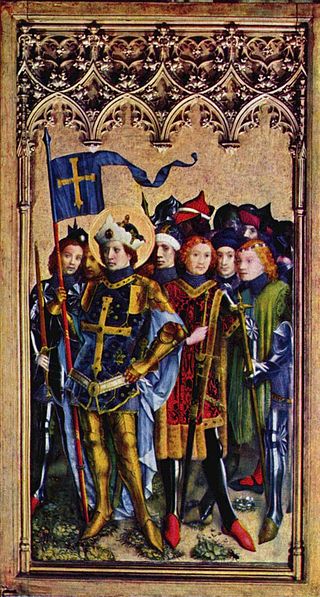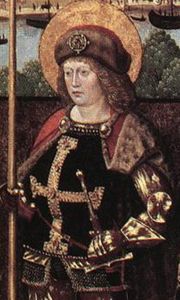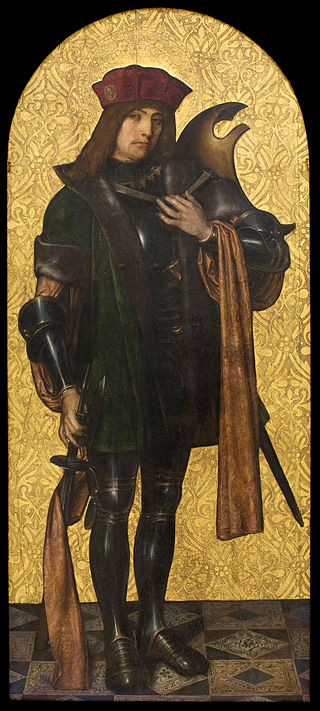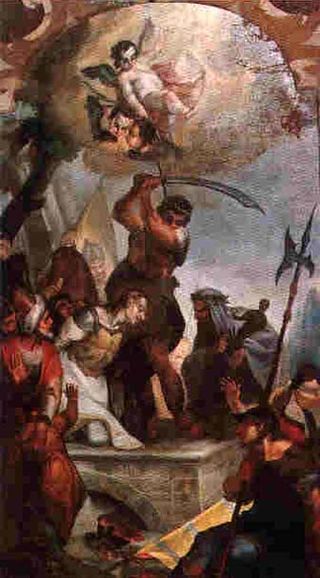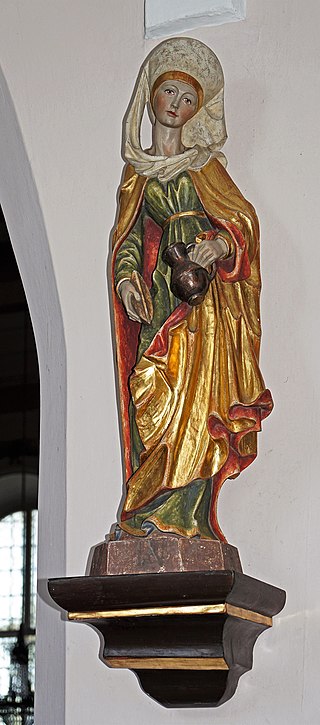This article relies largely or entirely on a single source .(March 2013) |
Saint Bessus | |
|---|---|
 Fresco of St. Bessus in the Cathedral of Ivrea | |
| Martyr | |
| Died | 3rd century Piedmont |
| Venerated in | Roman Catholic Church |
| Feast | August 10; December 1 |
| Attributes | depicted as a soldier bearing a banner with the Mauritian Cross and the palm of martyrdom; spade; helmet with an ostrich feather [1] |
| Patronage | Ivrea (with Sabinus); Campiglia; Valprato Soana; Cogne; protector of soldiers against the dangers of war; also invoked for fertility [1] |
Bessus, sometimes Besse, (Italian : San Besso) is venerated as a member of the legendary Theban Legion, whose members were led by Maurice and were martyred for their Christian faith in the 3rd century. [1] Except for the cult of Saint Maurice, veneration for Bessus enjoyed a wider popularity than those associated with other saints of the Theban Legion and remains popular today. [1] According to tradition, Constantius survived the decimation of his legion and fled to valleys of Aosta and Cogne. He then dedicated himself to converting the people in this area to Christianity. [1]
Contents
Evidence for Bessus's existence is confused and uncertain: the name of Bessus is actually identified with two different, semi-legendary saints with the same name: one was a martyred bishop of Ivrea who lived in the eighth century, the other was a hermit with the same name who lived in an Alpine sanctuary near Campiglia in Cogne Valley. [1] In addition, there are two feast days associated with Bessus that were celebrated at Ivrea: August 10 and December 1. [1] The cult of Saint Bessus may actually represent the Christianization of the cult associated with the Egyptian god Bes, also invoked for fertility. [1] Bessus and Bes, as Fabio Arduino points out, are both associated with an ostrich feather in their iconography. [1]
Numerous legends were connected with Bessus. A breviary dating from 1473 states that Bessus was martyred in the following manner: he was invited to a banquet by some Piedmontese who had stolen the cattle that was now being served as a meal. When Bessus discovered this, he denounced the cattle thieves. Angered, the thieves chased him and forced him to jump the cliffs of Monte Fautenio. Bessus survived but was then killed by the Roman legionnaires who had slaughtered the Theban Legion at Agaunum. [1] The cliff preserves an imprint associated with Bessus. [1] According to local tradition, the sanctuary dedicated to the saint was constructed on the place of Bessus's martyrdom, which remains today a place of pilgrimage. [1] A different version of the tale states that Bessus hid himself in the Valley of Cogne before being killed by the Roman soldiers. [1]
In 1912, Robert Hertz, a French historian and anthropologist, collected at Cogne a different version of Bessus's death, which was part of an oral tradition passed down from generation to generation. This version states that Bessus was not a soldier of the Theban Legion at all, but a local shepherd who was so pious that God rewarded him with a prosperous, fat, and healthy flock. Envious of his prosperity, some shepherds killed him by forcing him off a cliff. [1]

